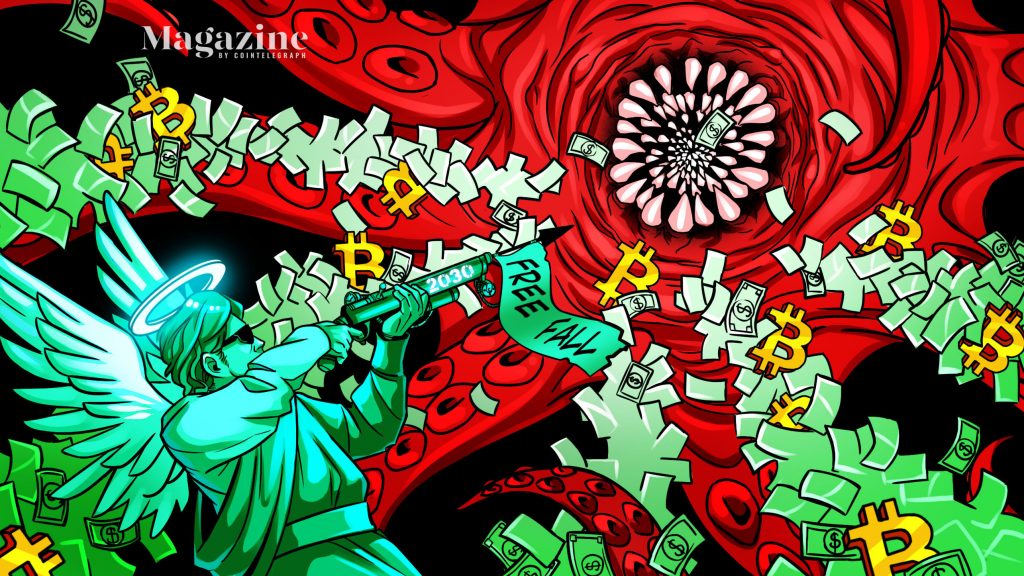Winklevoss Strikes Back Against Goldman Sachs’ Bitcoin Whack
Goldman Sachs has delivered a Roubini-esque broadside against Bitcoin, arguing that its bubble (see: things that happened in 2017) was almost five times frothier than the Tulip Bubble (see: things that happened in 1637).
In a PowerPoint presentation resembling something outsourced to a 15-year-old on Fiverr, the storied bank warned clients to shy away from the cryptocurrency that investors elsewhere are clamoring to get their hands on.
Goldman Sachs doesn’t have hands, however. It has tentacles, as depicted in Matt Taibbi’s famous Rolling Stone Magazine story on the finance sector behemoth:
“The great vampire squid wrapped around the face of humanity, relentlessly jamming its blood funnel into anything that smells like money.”
Tyler Winklevoss delivered a scathing takedown on Twitter:
Crypto used to be where you ended up when you couldn’t make it on Wall Street. The quality of Goldman Sachs’ recent research on #Bitcoin demonstrates that there has been a talent flippening. Today, Wall Street is where you end up when you can’t make it in crypto.
— Tyler Winklevoss (@tyler) May 27, 2020
The Vampire Squid’s Bubbly History
If anyone can spot a bubble, it’s Goldman Sachs. In fact, they tend to create them.
Goldman Sachs’ investment trust-upon-trust-upon-trust scam played a major role in the market crash in 1929 (see: mechanisms we can employ to make a point, too) and left wide-eyed economist John Kenneth Galbraith impressed at the pure madness of it all:
“It is difficult not to marvel at the imagination which was implicit in this gargantuan insanity.”
The bubble-maker’s role in the dot com boom and bust was also significant. Its use of laddering and kickback bribes among “in the know” investors led to overpriced IPOs, retail investors left holding the bag, and a trail of lawsuits.
The firm also faced the risk of criminal charges for its role in the housing bubble — and subsequent crash — that caused the Global Financial Crisis… the one that resulted in the creation of Bitcoin. But, inevitably, none were brought. Why? No idea, although this excerpt from Wikipedia might lead the astute reader to draw some conclusions. (Incidentally, Goldman Sachs uses the term ‘Conviction Buy’ to rate stocks that it perceives to have strong potential. A corollary of this handy term is that internet searches for “Goldman Sachs convictions” turn up nothing relating to criminality on the first page of Google results. If banking doesn’t work out, maybe a career in SEO?)
A 635-page Senate report outlined the bank’s misdeeds leading up to the crisis. With loosened lending criteria for homeowners leading to billions of dollars of toxic mortgage debts, Goldman Sachs bundled up those debts and sold them to pension funds and insurance companies.
They then took short positions against their clients, knowing the bubble would eventually pop. For its trouble, it received almost $13 billion in bailout money and paid then-CEO Lloyd Blankfein a handy $9 million bonus in the same year that Bitcoin was created.
Wikipedia warns readers that the Controversies and legal issues section on their page about the bank:
“… may be too long to read and navigate comfortably.”
You can put lipstick on a pig. But it’s still a pig.
And if you throw a TARP over a giant vampire squid, it’s still a tentacled monstrosity.
Goldman Sachs wins the week’s Epic Fail Trophy.
Let’s see if they overprice it, bundle it up to flog off to unsuspecting clients, and short it.
Headlines From the Year 2030
Goldman Sachs stocks were down again today, closing 13% lower as the ailing behemoth was slapped with another trillion-dollar fine for its role in the Student Talent Untapped Potential Indemnified Debt (STUPID) meltdown.
STUPIDs were undercollateralized ‘guaranteed’ debt swaps which duped investors into buying student loans against future graduate incomes. The student debt crisis unfolded as the mass strategic bankruptcy among university graduates brought the economy to its knees.
Indebted students across the country were sold STUPID loan buyouts, which offered interest rates of 1.5%. The fine print had those rates climb, in some cases, to as high as 375% by the second year.
Now in private hands, many graduates decided to simply walk away from repayments under the crushing weight of their obligations. STUPIDs were packaged up by Goldman Sachs and parceled out to investors, who were promised ‘guaranteed’ annual earnings of almost 4x their investment, payable in the bank’s own digital currency (SAX: -99.98%)
May 29, 2030 New Caledonia Post: Fed Intervenes With Eight Trillion Dollar Bailout
The U.S. government announced a rescue package of $8 trillion to bailout the institutions holding toxic student loan debt. Named the Critical Response Act for Valued Enterprises, the CRAVE-STUPID bill will provide rescue packages for financial services companies impacted by the crisis.
Goldman Sachs is set to receive around $2 trillion of the CRAVE-STUPID fund. Half of it has been earmarked to pay the fine imposed on the bank by New York regulators. The other half will be set aside for executive bonuses, according to a source who asked to remain nameless.
Hank Paulson Jnr., former Goldman Sachs CEO and now White House Treasury Secretary, said CRAVE-STUPID was intended to shore up the financial system crippled by the toxic Sachs-backed securities. When pushed on why Goldman Sachs was set to receive so much of the bailout when it was responsible for creating STUPIDs, Paulson Jnr. told reporters:
“That’s what we always do. Goldman Sachs creates financial carnage and taxpayers clean it up. Without the bailout half of it, the system would grind to a halt. D’uh.”
CMC 500 Marches On
With the S&P 500 flashing red across the board, the CMC 500 continues its steady decade-long pattern of growth, with digital assets now enjoying an all-time high market cap roughly six times that of gold…
(Thanks 2030! You Nailed It!)
Opinions expressed in this column are those of the author.

Paul de Havilland
Fake JD stablecoins, scammers impersonate Solana devs: Asia Express
